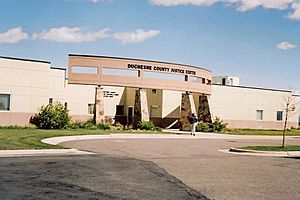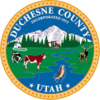Duchesne County, Utah facts for kids
Quick facts for kids
Duchesne County
|
||
|---|---|---|

Duchesne County Courthouse in Duchesne
|
||
|
||

Location within the U.S. state of Utah
|
||
 Utah's location within the U.S. |
||
| Country | ||
| State | ||
| Founded | January 4, 1915 (proclaimed in effect) | |
| Named for | Duchesne River | |
| Seat | Duchesne | |
| Largest city | Roosevelt | |
| Area | ||
| • Total | 3,256 sq mi (8,430 km2) | |
| • Land | 3,241 sq mi (8,390 km2) | |
| • Water | 15 sq mi (40 km2) 0.50% | |
| Population
(2020)
|
||
| • Total | 19,596 | |
| • Density | 6.0184/sq mi (2.3237/km2) | |
| Time zone | UTC−7 (Mountain) | |
| • Summer (DST) | UTC−6 (MDT) | |
| Congressional district | 1st | |
Duchesne County (/duːˈʃeɪn/ DOO-shayn) is a county in the northeast part of the U.S. state of Utah. As of the 2020 United States Census, the population was 19,596. Its county seat is Duchesne, and the largest city is Roosevelt.
Contents
History
Much of Duchesne County was part of the Uintah Reservation, created 1861 by US President Abraham Lincoln as a permanent home of the Uintah and White River Utes. Later the Uncompahgre Utes were moved to the Uintah and newly created Uncompahgre Indian reservations from western Colorado. At the turn of the century, under the Dawes Act, both Indian reservations were thrown open to homesteaders. This was done after allotments of land were made to Indians of the three tribes. The homesteading process was opened on the Uintah on August 27, 1905.
Unlike much of the rest of Utah Territory, settlement of the future Duchesne County area did not occur due to LDS Church pressures. It was settled by individuals who obtained 160 acres under the federal Homestead Act. Homesteaders were required to prove that they intended to farm the land. After five years of living on the land, making improvements, and paying $1.25 per acre, homesteaders were given title to their homesteads.
On July 13, 1914, a referendum was presented to voters of Wasatch County to partition the eastern part into a separate county. The referendum passed, so Utah Governor William Spry proclaimed on January 4, 1915. The county seat was decided by county vote on November 5, 1914, election. The new county was named for its county seat, which in turn was called for the Duchesne River, which flows southward and then eastward through the central part of the county near the city. Its name is of uncertain origin, but the holding theory is that fur trappers named it in the 1820s in honor of Mother Rose Philippine Duchesne, founder of the School of the Sacred Heart near St. Louis, Missouri, although other theories as to the name exist. The county boundary with Uintah County was adjusted by legislative act on March 5, 1917; Duchesne County boundaries have remained in their current configuration since that date.
Geography
Duchesne County's terrain is semi-arid, rough, and scarred with drainages. The Duchesne River drains the central part of the county. The county generally slopes to the south and east. The county has a total area of 3,256 square miles (8,430 km2), of which 3,241 square miles (8,390 km2) is land and 15 square miles (39 km2) (0.5%) is water. The northern part of the county contains much of the east–west oriented Uinta Mountains. The highest natural point in Utah, Kings Peak at 13,528 feet (4,123 m), is located in Duchesne County.
Major highways
 US-40
US-40 US-191
US-191- SR-35
- SR-87
- SR-121
 SR-150
SR-150- SR-208
Adjacent counties
- Summit County - north
- Daggett County - northeast
- Uintah County - east
- Carbon County - south
- Utah County - southwest
- Wasatch County - west
Protected areas
- Ashley National Forest (part)
- Big Sand State Park
- Currant Creek Wildlife Management Area
- High Uintas Wilderness (part)
- Red Creek Wildlife Management Area
- Skitzy Wildlife Management Area
- Starvation State Park
- Wasatch-Cache National Forest (part)
Lakes
- Big Sand Wash Reservoir
- Cedar View Reservoir
- Chepeta Lake
- Crater Lake
- Daynes Lake
- Grandaddy Lake
- Kidney Lake
- Lake Atwood
- Mirror Lake
- Moon Lake
- Starvation Reservoir
- Upper Stillwater Reservoir
Demographics
| Historical population | |||
|---|---|---|---|
| Census | Pop. | %± | |
| 1920 | 9,093 | — | |
| 1930 | 8,263 | −9.1% | |
| 1940 | 8,958 | 8.4% | |
| 1950 | 8,134 | −9.2% | |
| 1960 | 7,179 | −11.7% | |
| 1970 | 7,299 | 1.7% | |
| 1980 | 12,565 | 72.1% | |
| 1990 | 12,645 | 0.6% | |
| 2000 | 14,371 | 13.6% | |
| 2010 | 18,607 | 29.5% | |
| 2020 | 19,596 | 5.3% | |
| US Decennial Census 1790–1960 1900–1990 1990–2000 2010 2020 |
|||
2020 census
According to the 2020 United States census and 2020 American Community Survey, there were 19,596 people in Duchesne County with a population density of 6.1 people per square mile (2.3/km2). Among non-Hispanic or Latino people, the racial makeup was 16,736 (85.4%) White, 21 (0.1%) African American, 875 (4.5%) Native American, 60 (0.3%) Asian, 39 (0.2%) Pacific Islander, 47 (0.2%) from other races, and 533 (2.7%) from two or more races. 1,285 (6.6%) people were Hispanic or Latino.
There were 9,933 (50.69%) males and 9,663 (49.31%) females, and the population distribution by age was 6,328 (32.3%) under the age of 18, 10,598 (54.1%) from 18 to 64, and 2,670 (13.6%) who were at least 65 years old. The median age was 33.3 years.
There were 6,511 households in Duchesne County with an average size of 3.01 of which 4,937 (75.8%) were families and 1,574 (24.2%) were non-families. Among all families, 3,986 (61.2%) were married couples, 363 (5.6%) were male householders with no spouse, and 588 (9.0%) were female householders with no spouse. Among all non-families, 1,312 (20.2%) were a single person living alone and 262 (4.0%) were two or more people living together. 2,748 (42.2%) of all households had children under the age of 18. 5,124 (78.7%) of households were owner-occupied while 1,387 (21.3%) were renter-occupied.
The median income for a Duchesne County household was $61,655 and the median family income was $69,216, with a per-capita income of $25,086. The median income for males that were full-time employees was $62,929 and for females $35,847. 13.9% of the population and 11.0% of families were below the poverty line.
In terms of education attainment, out of the 11,755 people in Duchesne County 25 years or older, 1,270 (10.8%) had not completed high school, 4,510 (38.4%) had a high school diploma or equivalency, 4,362 (37.1%) had some college or associate degree, 1,159 (9.9%) had a bachelor's degree, and 454 (3.9%) had a graduate or professional degree.
2010 census
As of the 2010 United States Census, there were 18,607 people, 6,003 households, and 4,703 families in the county. The population density was 5.74 people per square mile (2.22 people/km2). There were 6,988 housing units at an average density of 2.16 units per square mile (0.83 units/km2). The racial makeup of the county was 89.15% White, 0.24% Black or African American, 4.53% Native American, 0.28% Asian, 0.27% Pacific Islander, 2.64% from other races, and 2.89% from two or more races. 6.00% of the population were Hispanic or Latino of any race.
There were 6,003 households, of which 40.23% had children under 18 living with them, 64.72% were married couples living together, 8.65% had a female householder with no husband present, and 21.66% were non-families. 45.0% of all households had individuals under 18, and 22.6% had someone living alone who was 65 years of age or older. The average household size was 3.05, and the average family size was 3.47.
The county population contained 33.91% under the age of 18, 6.56% from 20 to 24, 25.38% from 25 to 44, 20.92% from 45 to 64, and 10.66% who were 65 years of age or older. The median age was 29.7 years. For every 100 females, there were 102.80 males. For every 100 females aged 18 and over, there were 100.00 males.
The median income for a household in the county was $31,298, and the median income for a family was $35,350. Males had a median income of $31,988 versus $19,692 for females. The per capita income for the county was $12,326. About 14.20% of families and 16.80% of the population were below the poverty line, including 19.60% of those under age 18 and 12.40% of those aged 65 or over.
Ancestry
As of 2015 the largest self-reported ancestry groups in Duchesne County, Utah are:
| Largest ancestries (2015) | Percent |
|---|---|
| English | 31.9% |
| German | 10.6% |
| Irish | 7.4% |
| American | 6.4% |
| Danish | 4.5% |
| Scottish | 4.3% |
| Swedish | 3.2% |
| Italian | 2.3% |
| Norwegian | 1.6% |
| Welsh | 3.1% |
Communities
Cities
Towns
Census-designated places
Unincorporated communities
- Altonah
- Arcadia
- Boneta
- Bridgeland
- Crescent
- Fruitland
- Hanna
- Hayden (part)
- Ioka
- Monarch
- Mount Emmons
- Mountain Home
- Stockmore
- Strawberry
- Talmage
- Upalco
- Utahn
Former communities
- Cedarview
- Harper
Education
All areas in the county are in the Duchesne School District.
See also
 In Spanish: Condado de Duchesne para niños
In Spanish: Condado de Duchesne para niños


